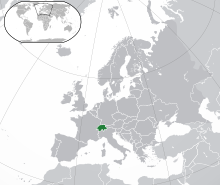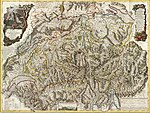
A | B | C | D | E | F | G | H | CH | I | J | K | L | M | N | O | P | Q | R | S | T | U | V | W | X | Y | Z | 0 | 1 | 2 | 3 | 4 | 5 | 6 | 7 | 8 | 9
 The location of Switzerland (dark green) in Europe | |
| Total population | |
|---|---|
| 20,000[1] | |
| Regions with significant populations | |
| Zürich, Geneva and Basel | |
| Languages | |
| Swiss German, Swiss Standard German, Swiss French, Swiss Italian, Romansh, Hebrew, Yiddish | |
| Religion | |
| Judaism |
| Part of a series on |
| Jews and Judaism |
|---|
| History of Switzerland |
|---|
 |
| Early history |
| Old Swiss Confederacy |
|
| Transitional period |
|
| Modern history |
|
| Timeline |
| Topical |
|
|



The history of the Jews in Switzerland extends back at least a thousand years. Jews and Judaism have been present in the territory of what is now Switzerland since before the emergence of the medieval Old Swiss Confederacy in the 13th century (the first communities settling in Basel in 1214).
Switzerland has Europe's tenth-largest Jewish community, with about 20,000 Jews,[1] roughly 0.4% of the population. The majority of the Jewish communities are domiciled in the largest cities of the country, i.e. in Zürich, Geneva and Basel.
The first World Zionist Congress of 1897 was held in Basel, and took place ten times in the city — more than in any other city in the world. Basel is also home to the Jewish Museum of Switzerland, the first Jewish museum to have been opened in German-speaking Europe after the Second World War. Whereas the communities of Basel and Zürich are traditionally shaped by large Ashkenazi communities, Geneva also hosts an important Sephardic community. Its main synagogue, the Synagogue Hekhal Haness, is considered to be the most important Sephardic synagogue in Switzerland.
History
Early history
A ring with a Menorah depiction found in Augusta Raurica (Kaiseraugst, Switzerland) in 2001 attests to Jewish presence in Germania Superior, a province of the Roman Empire.[2] The Encyclopaedia Judaica mentions a first documentation of Jews in Switzerland in 1214. In the Middle Ages, as in many places in Europe, they frequently suffered persecution, for example in 1294 in Bern many Jews of the city were executed and the survivors expelled under the pretext of the murder of a Christian boy. Another pogrom occurred in Zürich in 1249. A plaque was mounted at the location of the former synagogue at Froschaugasse 4 in the former Neumarkt quarter to commemorate the pogrom.[3] The Jews were also victims of persecution during the Black Plague, which they were frequently accused of having caused by poisoning wells. In 1349, 600 Jews in Basel were burned at the stake and 140 children forcibly converted to Catholicism,[4] while in Zurich Jews' belongings were confiscated and a number of Jews were burned at the stake.[5] There were numerous such incidents during the period of the plague. In 1401, Schaffhausen was the location of the Schaffhausen Massacre.[6]
Early Modern period
Jews were banished from the Swiss Cantons in the 1620s. From 1776 they were allowed to reside exclusively in two villages, Lengnau and Oberendingen, in what is now the canton of Aargau. At the close of the 18th century, the 553 Jews in these villages represented almost the entire Jewish population in Switzerland. An important source for the situation of Swiss Jews in the 18th century is the 1768 Sammlung Jüdischer Geschichten by Johann Caspar Ulrich.
Beginning in 1603, the deceased Jews of the Surbtal communities were buried on a small island in the river Rhein, called Judenäule ("Jew's island") which had been leased to the Jewish community. As the island was repeatedly flooded and devastated, in 1750 the Surbtal Jews asked the Tagsatzung to establish a cemetery in the vicinity of their communities in the Surb valley. Once a year, the communal chevra kadisha (hevra kadishah, Aramaic: חברא קדישא, Ḥebh'ra Qaddisha, meaning "holy society") visited the graves on the island. In 1750 the Tagsatzung 'allowed' the Jewish communities of Endingen and Lengnau to purchase woodland on a small hill between Endingen and Lengnau to establish the Endingen cemetery. The cemetery has been expanded several times. Based on an agreement concluded in 1859, two-fifths of the cemetery belong to the Israelite community of Lengnau, and three-fifths to the Israelite community of Endingen.[7][8]

In accordance with a resolution of the Tagsatzung in 1678, Jews were allowed to settle in the communities of the Surb valley. After 1776, they were further restricted to residing in Endingen or Lengnau. Migration of Jews to these villages from elsewhere in Switzerland slowly but steadily changed the appearance of the communities. The village of Endingen never built a Christian church, only a Jewish synagogue. The local Christians traveled to neighboring villages for church services. Jewish and Christian families often lived under one roof.
Jewish residents were restricted as to the professions they could practise. Houses were built with two separate entrances, one for Jews and one for Christians.[9] They were under the jurisdiction of the high and low courts of the Baden bailiff and had to buy "protection and safety" letters patent from the authorities.[10] Furthermore, regulations in the 18th century decreed that Jews were allowed to buy and sell their livestock only in open markets and not directly from the farmer. Christians had no such regulations.[11][12]
Napoleonic era
In 1798, the French under Napoleon I invaded Switzerland and established the Helvetic Republic. The Republic attempted to modernize and centralize the Swiss Confederation which was not a unified country, but rather an alliance of sovereign states. As part of this new, liberal state, Swiss reformers attempted to emancipate the Jews in the new Helvetic Parliament in Aarau. When those efforts failed, they attempted to get the French to force this change on the new Swiss government. The changes of the Republic were not embraced by many of the Swiss and the issue of emancipation for the Jews became another contentious issue between the old order and the new government.
In 1802 a portion of the population revolted and turned against the Jews. The mob looted the Jewish villages of Endingen and Lengnau in the so-called Zwetschgenkrieg ("Plum war"). At the same time other revolts, such as the Stecklikrieg, stretched the French Army too thin for French authorities to guarantee the Jews' safety. Napoleon lacked the troops to bring peace to Switzerland, and needed the Swiss regiments for his campaigns. Seeking a peaceful resolution to the uprising, in 1803 he issued the Act of Mediation. The Act of Mediation was a compromise between the Ancien Regime and a Republic. One of the compromises in the Act was that no further rights were granted to the Jews.[13]
Modern Switzerland
By the mid-19th century the village of Endingen had about 2,000 inhabitants, about half Jews and half Christians. By comparison, the town of Baden had about 1,500 people at the same time.[9]
The Jewish population was fairly well tolerated, self-managed and maintained its own school. In 1862 the Jewish community of Zürich, the Israelitische Cultusgemeinde Zürich (ICZ) was founded, and in 1884 the Synagoge Zürich was built at the Löwenstrasse road.[14] In 1879 a Jewish village of Neu-Endingen was built. It remained mostly independent until 1983 when it merged back into the village of Endingen.[10]
The right to settle freely was not restored to Jews with the Swiss constitution of 1848, and was only granted after approval in a referendum in 1866. Two instrumental Jewish figures in the struggle for emancipation were teacher and publicist Markus G. Dreyfus[11] and rabbi and historian Meyer Kayserling.[15] The rights of Jews in Switzerland were strengthened with the revised constitution of 1874. Article 49 of the 1874 constitution guarantees the freedom of religion.
In 1876, the Jews were granted full equality in civil rights and allowed to travel. By 1920, most Jews had left the Surb Valley. During the late 19th and early 20th centuries, many Jews from Alsace, Germany and Eastern Europe joined this core group. In 1920, the Jewish population had reached its peak at 21,000 people (0.5% of the total population), a figure that has remained almost constant ever since.
In 1999 Ruth Dreifuss became the first Jewish president of the Swiss Federal Council.
Language
Jews living in the Surb Valley once spoke a dialect of Western Yiddish, traces of which can be still found today in the region. Western Yiddish is mainly a mixture of High German dialects, with Hebrew and Aramaic vocabulary, as well as some influence from Romance languages. It is distinguished from Eastern Yiddish in that it has far fewer Slavic loanwords (see Yiddish). Unlike Eastern Yiddish, which is spoken to some degree by Polish and American Jews, Western Yiddish has almost disappeared. Today there are only a few, mostly elderly Jews who know the dialect of the Surb Valley Jews, and the Sound Archives at the University of Zurich have begun recording what is left of the dialect.
Demographics
According to the 2000 census, the Jewish population of Switzerland was at 17,914 (0.2% of the total population). In 2015 there were 17,250 Jewish people over the age of 15 in Switzerland (about 0.25% of the total).[16] Although the number of Jews has remained fairly stable since the thirties, their percentage of the Swiss population has fallen considerably. This plateau is due to immigration, without which Swiss Jews could not have prevented a demographic setback, linked to an aging population and the many mixed marriages. Among the Cantons of Switzerland, only Zurich, Basel-City, Geneva and Vaud have a Jewish community exceeding 1,000 people. One third of Swiss Jews reside in the Canton of Zurich (in 2015, 6,045 people over 15).[16]
| Year | Jewish population | % |
|---|---|---|
| 1850 | 3,145 | 0.1 |
| 1860 | 4,216 | 0.2 |
| 1870 | 6,996 | 0.3 |
| 1880 | 7,373 | 0.3 |
| 1888 | 8,069 | 0.3 |
| 1900 | 12,264 | 0.4 |
| 1910 | 18,462 | 0.5 |
| 1920 | 20,979 | 0.5 |
| 1930 | 17,973 | 0.4 |
| 1941 | 19,429 | 0.4 |
| 1950 | 19,048 | 0.4 |
| 1960 | 19,984 | 0.4 |
| 1970 | 20,744 | 0.3 |
| 1980 | 18,330 | 0.3 |
| 1990 | 17,577 | Zdroj:https://en.wikipedia.org?pojem=Judaism_in_Switzerland
